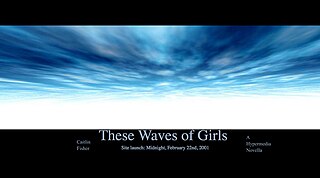
Hypertext is text displayed on a computer display or other electronic devices with references (hyperlinks) to other text that the reader can immediately access. Hypertext documents are interconnected by hyperlinks, which are typically activated by a mouse click, keypress set, or screen touch. Apart from text, the term "hypertext" is also sometimes used to describe tables, images, and other presentational content formats with integrated hyperlinks. Hypertext is one of the key underlying concepts of the World Wide Web, where Web pages are often written in the Hypertext Markup Language (HTML). As implemented on the Web, hypertext enables the easy-to-use publication of information over the Internet.

Memex is a hypothetical electromechanical device for interacting with microform documents and described in Vannevar Bush's 1945 article "As We May Think". Bush envisioned the memex as a device in which individuals would compress and store all of their books, records, and communications, "mechanized so that it may be consulted with exceeding speed and flexibility". The individual was supposed to use the memex as an automatic personal filing system, making the memex "an enlarged intimate supplement to his memory". The name memex is a portmanteau of memory and expansion.

In computing, a hyperlink, or simply a link, is a digital reference to data that the user can follow or be guided to by clicking or tapping. A hyperlink points to a whole document or to a specific element within a document. Hypertext is text with hyperlinks. The text that is linked from is known as anchor text. A software system that is used for viewing and creating hypertext is a hypertext system, and to create a hyperlink is to hyperlink. A user following hyperlinks is said to navigate or browse the hypertext.
Project Xanadu was the first hypertext project, founded in 1960 by Ted Nelson. Administrators of Project Xanadu have declared it superior to the World Wide Web, with the mission statement: "Today's popular software simulates paper. The World Wide Web trivialises our original hypertext model with one-way ever-breaking links and no management of version or contents."
In the context of the World Wide Web, deep linking is the use of a hyperlink that links to a specific, generally searchable or indexed, piece of web content on a website, rather than the website's home page. The URL contains all the information needed to point to a particular item. Deep linking is different from mobile deep linking, which refers to directly linking to in-app content using a non-HTTP URI.
This article presents a timeline of hypertext technology, including "hypermedia" and related human–computer interaction projects and developments from 1945 on. The term hypertext is credited to the author and philosopher Ted Nelson.

ZOG was an early hypertext system developed at Carnegie Mellon University during the 1970s by Donald McCracken and Robert Akscyn. ZOG was first developed by Allen Newell and George G. Robertson to serve as the front end for AI and Cognitive Science programs brought together at CMU for a summer workshop. The ZOG project was as an outgrowth of long-term artificial intelligence research led by Allen Newell and funded by the Office of Naval Research. A second version of ZOG was installed as the key interface between users and logistics on the Nimitz class carrier USS Carl Vinson in 1983.

NoteCards was a hypertext-based personal knowledge base system developed at Xerox PARC by Randall Trigg, Frank Halasz and Thomas Moran in 1984. NoteCards was developed after Trigg's pioneering 1983 Ph.D. thesis on hypertext while at the University of Maryland College Park.
Hypermedia, an extension of the term hypertext, is a nonlinear medium of information that includes graphics, audio, video, plain text and hyperlinks. This designation contrasts with the broader term multimedia, which may include non-interactive linear presentations as well as hypermedia. It is also related to the field of electronic literature. The term was first used in a 1965 article written by Ted Nelson.
In the context of a web browser, a frame is a part of a web page or browser window which displays content independent of its container, with the ability to load content independently. The HTML or media elements in a frame may come from a web site distinct from the site providing the enclosing content. This practice, known as framing, is today often regarded as a violation of same-origin policy.
An autolink is a hyperlink added automatically to a hypermedia document, after it has been authored or published. Automatic hyperlinking describes the process or the software feature that produces autolinks. Segments of the hypermedia are identified through a process of pattern matching. For example, in hypertext, the software could recognise textual patterns for street addresses, phone numbers, ISBNs, or URLs.
NLS, or the "oN-Line System", was a revolutionary computer collaboration system developed in the 1960s. Designed by Douglas Engelbart and implemented by researchers at the Augmentation Research Center (ARC) at the Stanford Research Institute (SRI), the NLS system was the first to employ the practical use of hypertext links, the mouse, raster-scan video monitors, information organized by relevance, screen windowing, presentation programs, and other modern computing concepts. It was funded by ARPA, NASA, and the US Air Force.

In information systems, a tag is a keyword or term assigned to a piece of information. This kind of metadata helps describe an item and allows it to be found again by browsing or searching. Tags are generally chosen informally and personally by the item's creator or by its viewer, depending on the system, although they may also be chosen from a controlled vocabulary.
The marquee tag is a non-standard HTML element which causes text to scroll up, down, left or right automatically. The tag was first introduced in early versions of Microsoft's Internet Explorer, and was compared to Netscape's blink element, as a proprietary non-standard extension to the HTML standard with usability problems. The W3C advises against its use in HTML documents.
Adaptive hypermedia (AH) uses hypermedia which is adaptive according to a user model. In contrast to regular hypermedia, where all users are offered the same set of hyperlinks, adaptive hypermedia (AH) tailors what the user is offered based on a model of the user's goals, preferences and knowledge, thus providing links or content most appropriate to the current user.
Hypervideo, or hyperlinked video, is a displayed video stream that contains embedded, interactive anchors, allowing navigation between video and other hypermedia elements. Hypervideo is similar to hypertext, which allows a reader to click on a word in one document and retrieve information from another document, or from another place in the same document. Hypervideo combines video with a non-linear information structure, allowing a user to make choices based on the content of the video and the user's interests.

The history of wikis began in 1994, when Ward Cunningham gave the name "WikiWikiWeb" to the knowledge base, which ran on his company's website at c2.com, and the wiki software that powered it. The wiki went public in March 1995, the date used in anniversary celebrations of the wiki's origins. c2.com is thus the first true wiki, or a website with pages and links that can be easily edited via the browser, with a reliable version history for each page. He chose "WikiWikiWeb" as the name based on his memories of the "Wiki Wiki Shuttle" at Honolulu International Airport, and because "wiki" is the Hawaiian word for "quick".

The Lively Kernel is an open-source web programming environment, developed by Dan Ingalls when he was at SAP Research. It supports desktop-style applications with rich graphics and direct manipulation abilities, but without the installation or upgrade troubles of conventional desktop applications. Development began at Sun Microsystems Laboratories in Menlo Park, California, and later moved to the Hasso Plattner Institute in Potsdam-Babelsberg near Berlin.

Hypertext is text displayed on a computer or other electronic device with references (hyperlinks) to other text that the reader can immediately access, usually by a mouse click or keypress sequence. Early conceptions of hypertext defined it as text that could be connected by a linking system to a range of other documents that were stored outside that text. In 1934 Belgian bibliographer, Paul Otlet, developed a blueprint for links that telescoped out from hypertext electrically to allow readers to access documents, books, photographs, and so on, stored anywhere in the world.

These Waves of Girls is a hypermedia novella by Caitlin Fisher that won the Electronic Literature Organization's Award for Fiction in 2001. The work is frequently taught in undergraduate literature courses and is referenced in the field of electronic literature as a significant example of early multimodal web-based hypertext fiction, placing Fisher "at the forefront of digital writing".







